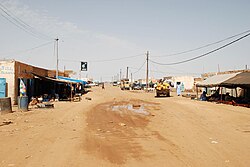Brakna
|
Brakna ولاية البراكنة |
|
|---|---|
| Region of Mauritania | |
 |
|
 |
|
| Coordinates: 17°38′N 13°25′W / 17.633°N 13.417°WCoordinates: 17°38′N 13°25′W / 17.633°N 13.417°W | |
| Country |
|
| Departments | |
| Capital | Aleg |
| Area | |
| • Total | 33,800 km2 (13,100 sq mi) |
| Population (2013 census) | |
| • Total | 312,277 |
| • Density | 9.2/km2 (24/sq mi) |
Brakna (Arabic: ولاية البراكنة) is a region in south-west Mauritania. Its capital is Aleg. Other major cities/towns include Boghé. The region borders the Mauritanian region of Tagant to the north-east, the Mauritanian regions of Assaba and Gorgol to the south-east, Senegal to the south-west and the Mauritanian region of Trarza to the north-west. The Sénégal River runs along the region's border with Senegal.
As of 2013, the population of the region was 312,277, compared to 309,307 in 2011. There were 46.96 per cent females and 53.04 per cent males. As of 2008, the activity rate was 40.30 and economic dependency ratio was 1.01. As of 2008, the literacy rate for people aged 15 years and over was 50.30. The net enrollment ratio of children for secondary level was 7.10 per cent.
Mauritania is mostly covered with desert, with only its western regions around the coast of Atlantic Ocean having some vegetation. There are some oasis in the desert regions. Since it is a desert, there are large shifting dunes forming temporary ranges. The average elevation is around 460 m (1,510 ft) above the mean sea level. The rainfall in the northern regions closer to the Tropic of Cancer receives around 100 mm (3.9 in) of annual rainfall compared to the southern portions that receives around 660 mm (26 in). The average temparature is 37.8 °C (100.0 °F), while during the night it reaches 0 °C (32 °F). Due to the geography, the inhabitants historically, have been nomadic. In modern times, people have migrated to urban centres during the drought in 1970 and 1980. There are a few sedantary cultivators, who are located only in the Southern regions of the country. Research has indicated that the Saharan movement has resulted in reduction of rains in the region from the 1960s, when it received close to 250 mm (9.8 in) of rainfall.
...
Wikipedia
